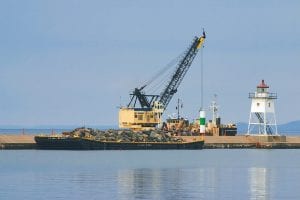Staff photo/Laurie Johnson North Shore residents were surprised the morning of Tuesday, May 12, to see a flotilla of US Army Corps of Engineers ships in the Grand Marais harbor. According to Master David J. Curran the Derrick Barge H.J. Schwartz is salvaging rocks that had fallen off the breakwall in recent ice storms and adding others imported from Duluth to fill gaps. While in Grand Marais, they will also be replacing the wire lifeline on the western breakwall and repainting caution markings on the support structure.

A pleasant surprise greeted North Shore residents as they passed the Grand Marais harbor in the early hours of Tuesday, May 12. The U.S. Corps of Engineers, with Derrick Barge H.J. Schwartz and the tug Hammond Bay, as well as two barges piled high with boulders, were hard at work repairing the outer breakwall on the west side of the harbor.
According to Master David J. Curran the Derrick Barge H.J. Schwartz is salvaging rocks that had fallen off the breakwall in recent ice storms and adding others imported from Duluth to fill gaps. While in Grand Marais, the Corps will also be replacing the wire lifeline on the western breakwall and repainting caution markings on the support structure.
The crane-barge H.J. Schwartz was built in 1996 by Peterson Builders in Sturgeon Bay, WI, and was the first new construction of a significant vessel for the Corps Lake Superior fleet since 1953. Its cost was $6 million. Theprimary mission of the Schwartz is to repair damage to navigation control structures.
According to a fleet information brochure, during a typical breakwater repair, the Schwartz handles stones ranging from 300 pounds to 40,000 pounds. It has a 70-ton crane capable of lifting 140,000 pounds at a 40-foot radius and can reach water depths of 32-feet. It is 150-feet long, 48-feet wide and has a draft of eight-feet.
The Cook County News-Herald asked the Schwartz’s crane operator, who preferred to be identified only as “Steve T.” how many stones the massive crane lifts at a time. Steve T. replied simply, “As many as I need.”
With the Schwartz is the tug Hammond Bay, which was built in 1954 by Roamer Boat Company at Holland, Michigan at a cost of $53,500. The Hammond Bay is a Tender Class III tug and is used by the Corps to move unpowered derrick barges, crane barges, and work scows during maintenance of navigation structures. The Hammond Bay is 45 feet long, 13-feet wide and has a draft of six-feet.
The vessels are part of the Corps of Engineers’ Twin Ports fleet, which maintains approximately 20 federal harbors and channels on the U.S. side of Lake Superior and Lake Michigan.



Loading Comments